The Erlangen Test of Activities of Daily Living (E-ADL test) is a performance test for assessing the basic activities of daily living (ADLs) of people with dementia. Compared with self-assessment and external assessment, conducting the test as a performance test has the great advantage that the test result is not influenced by the various assessment errors that can occur in self-assessment or external assessment. The performance test result is therefore significantly more valid than assessment results.
In research, the performance test can be carried out by “blinded” testers, a practice that increases the test’s informative value even further.
The test takes only about 8 minutes on average and is therefore highly economical. The test has been comprehensively validated.
The E-ADL test can be used both in practice (to determine ADL abilities) and in research (particularly in therapy studies). The test results show good interindividual differentiation in the areas of moderate and severe dementia.
The test consists of a total of five tasks: (1) Pouring a drink, (2) Cutting a piece of bread, (3) Opening a small cupboard, (4) Washing hands, and (5) Tying a bow.
| E-ADL item | Maximal Score |
| (1) Pouring a drink | 6 |
| (2) Cutting a piece of bread | 6 |
| (3) Opening a small cupboard | 6 |
| (4) Washing hands | 6 |
| (5) Tying a bow | 6 |
Note: Due to regional characteristics, it may be necessary to adapt a specific item to local customs. For example, if it is not customary in a particular region to eat bread, then bread can be replaced by another staple food that can be cut and is suitable for this purpose.
A detailed list of materials can be downloaded here.
- Task 1: Pouring a drink. A plastic bottle and a glass are required. The aim is to open the bottle and pour the liquid into the glass.

- Task 2: Cutting a piece of bread. A small board, knife and fork, a slice of bread and butter/margarine are required. The bread should be spread and cut in half.
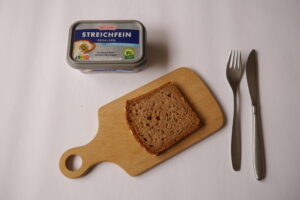
- Task 3: Opening a small cupboard. The small cupboard is locked with a key so that the person being tested must be able to turn the key. The bar of soap inside the cupboard should be taken out.
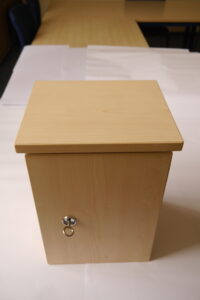
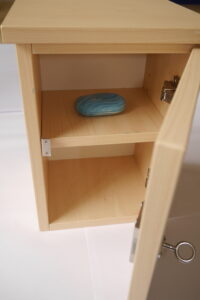
- Task 4: Washing hands. A small tub filled with water is provided. The bar of soap (Task 3) is placed on a small shelf. A towel is provided for drying off. The extent to which the hands can be soaped and washed is checked.
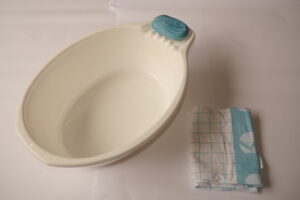
- Task 5: Tying a bow. A bow should be tied on a prepared box.
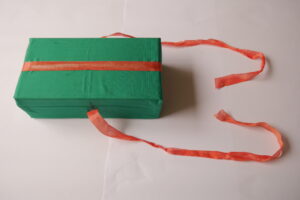

Requirements for conducting the test:
- existing vision and hearing ability and
- the absence of significant motor impairments that could prevent the person from performing the tasks.
Test environment: The test should be conducted in a quiet room with good lighting. The test materials are placed on a table and should be easily accessible to the person being tested. The person conducting the test and the person being tested sit opposite each other at a table. Objects that could distract the person being tested should be removed or placed in the room in such a way that they do not interfere with the test.
Test procedure: Instructions for an individual task may be repeated no more than twice, and only in their entirety, not in parts! Once the test subject has begun to solve a task (first substep), the instructions may no longer be repeated.
As soon as the test subject stops performing a task (regardless of how much they have completed), the item is considered complete, and you can proceed with the evaluation. After awarding the points, the test subject should be helped to complete the task so that a standardized continuation of the E-ADL test is possible (see Items 3 and 4) and further testing is not overshadowed by feelings of frustration on the part of the test subject.
Graessel, E., Viegas, R., Stemmer, R., Küchly, B., Kornhuber, J., & Donath, C. (2009). The Erlangen Test of Activities of Daily Living: first results on reliability and validity of a short performance test to measure fundamental activities of daily living in dementia patients. International Psychogeriatrics, 21(1), 103-112.
Luttenberger, K., Schmiedeberg, A., & Gräßel, E. (2012). Activities of daily living in dementia: revalidation of the E-ADL test and suggestions for further development. BMC Psychiatry, 12, 1-10.
You can register to download the test here.
! Those responsible for this website guarantee that all information provided during registration will be treated confidentially, in particular that it will not be passed on to third parties.
Downloading is permitted only for non-commercial use, which means specifically that
- no immediate (direct) costs are incurred by the person being tested (billing as a health insurance benefit by third parties, e.g., doctors, is possible) and
- the E-ADL test is not resold to third parties in any form as part of a larger test battery (e.g., as part of a larger, fee-based assessment instrument).
Erlangen Test of Activities of Daily Living (E-ADL); Activities of Daily Living (ADL)
